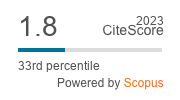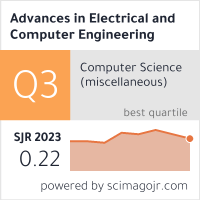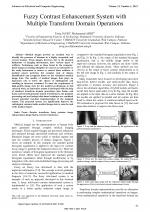| 1/2021 - 9 |
Fuzzy Contrast Enhancement System with Multiple Transform Domain OperationsJAVID, T. |
| View the paper record and citations in |
| Click to see author's profile in |
| Download PDF |
Author keywords
Fourier transform, fuzzy systems, image enhancement, image fusion, wavelet transforms
References keywords
image(14), fuzzy(11), enhancement(8), medical(7), systems(6), fusion(6), processing(5), information(5), histogram(5), equalization(5)
Blue keywords are present in both the references section and the paper title.
About this article
Date of Publication: 2021-02-28
Volume 21, Issue 1, Year 2021, On page(s): 83 - 90
ISSN: 1582-7445, e-ISSN: 1844-7600
Digital Object Identifier: 10.4316/AECE.2021.01009
Web of Science Accession Number: 000624018800009
SCOPUS ID: 85102794982
Abstract
Medical images provide an excellent way to identify the presence of diseases in a highly acceptable and correct manner. These images, however, due to the physical limitations of imaging instruments, have various types of artifacts. Techniques, such as those found in the computer-based image processing discipline are used as an alternative to the costly instrument to reduce or control these artifacts. A medical expert performs the complex task of disease identification and prognosis based on the visualized medical image data. The quality of medical images thus plays an important role to lower the chance of misdiagnosis and resulting in incorrect treatment. To meet the requirement of high-quality image data for the medical professional, in this research work, an innovative system is developed with the help of standard transform domain operations, data fusion, and fuzzy contrast enhancement system. Furthermore, the graphics processing unit and lookup table based technique are combined toward potential real-time implementation of the designed system. The proposed system can significantly improve the radiological contents inside medical image data to ease the task of the medical expert. |
| References | | | Cited By «-- Click to see who has cited this paper |
| [1] R. C. Gonzalez, R. E. Woods. Digital image processing. New Jersey, USA: Pearson Prentice Hall, pp. 169-189, 2008.
[2] W. Y. Hsu, C. Y. Chou, "Medical image enhancement using modified color histogram equalization," Journal of Medical and Biological Engineering, vol. 35, pp. 580-584, 2015. [CrossRef] [Web of Science Times Cited 24] [SCOPUS Times Cited 37] [3] P. Kandhway, A. K. Bhandari, A. Singh, "A novel reformed histogram equalization based medical image contrast enhancement using krill herd optimization," Biomedical Signal Processing and Control, vol. 56, p. 101677, 2020. [CrossRef] [Web of Science Times Cited 66] [SCOPUS Times Cited 86] [4] S. Saravanan, R. Karthigaivel, "A fuzzy and spline based dynamic histogram equalization for contrast enhancement of brain images," International Journal of Imaging Systems and Technology, pp. 1-26, 2020. [CrossRef] [Web of Science Times Cited 5] [SCOPUS Times Cited 11] [5] L. Bai, W. Zhang, X. Pan, C. Zhao, "Underwater image enhancement based on global and local equalization of histogram and dual-image multi-scale fusion," IEEE Access, vol. 8, pp.128973-128990, 2020. [CrossRef] [Web of Science Times Cited 58] [SCOPUS Times Cited 80] [6] A. M. Pour, H. Seyedarabi, S. H. A. Jahromi, A. Javadzadeh, "Automatic detection and monitoring of diabetic retinopathy using efficient convolutional neural networks and contrast limited adaptive histogram equalization," IEEE Access, vol. 8, pp. 136668-136673, 2020, [CrossRef] [Web of Science Times Cited 51] [SCOPUS Times Cited 82] [7] L. A. Zadeh, "Fuzzy sets," Information and Control, vol. 8, pp. 338-353, 1965. [CrossRef] [SCOPUS Times Cited 68421] [8] L. A. Zadeh, "Outline of a new approach to the analysis of complex systems and decision processes," IEEE Trans. on Systems, Man, and Cybernetics, vol. SMC-3, pp. 28-44, 1973. [CrossRef] [SCOPUS Times Cited 6526] [9] L. A. Zadeh, "A fuzzy-algorithmic approach to the definition of complex or imprecise concepts," International Journal of Man-Machine Studies, vol. 8, pp. 249-291, 1976. [CrossRef] [Web of Science Times Cited 365] [SCOPUS Times Cited 434] [10] K. P. Adlassnig, "Fuzzy set theory in medical diagnosis," IEEE Trans. on Systems, Man, and Cybernetics, vol. 16, pp. 260-265, 1986. [CrossRef] [Web of Science Times Cited 240] [SCOPUS Times Cited 335] [11] D. K. Iakovidis, E. Papageorgiou, "Intuitionistic fuzzy cognitive maps for medical decision making," IEEE Trans. on Information Technology in Biomedicine, vol. 15, pp. 100-107, 2010. [CrossRef] [Web of Science Times Cited 139] [SCOPUS Times Cited 174] [12] B. A. Akinnuwesi, B.A. Adegbite, F. Adelowo, U. Ima-Edomwonyi, G. Fashoto, O. T. Amumeji, "Decision support system for diagnosing rheumatic-musculoskeletal disease using fuzzy cognitive map technique," Informatics in Medicine Unlocked, vol. 18, p. 100279, 2020. [CrossRef] [SCOPUS Times Cited 23] [13] T. Javid, P. Akhtar, A. Dilshad, I. Mala, S. S. Zia, "Implementation of fuzzy rule-based contrast enhancement system," NED University Journal of Research, vol. Special Issue (ICONICS-2016), pp. 23-30, 2018. [14] S. Araghinejad. Data-driven modeling: Using MATLAB in water resources and environmental engineering. Dor-drecht, Netherlands: Springer, pp. 263-265, 2014. [15] S. Araghinejad, M. Azmi, M. Kholghi, "Application of artificial neural network ensembles in probabilistic hydrological forecasting," Journal of Hydrology, vol. 407, pp. 94-104, 2011. [CrossRef] [Web of Science Times Cited 58] [SCOPUS Times Cited 66] [16] D. L. Donoho, "Compressed sensing," IEEE Trans. Information Theory, vol. 52, pp. 1289-1306, 2006. [CrossRef] [Web of Science Times Cited 19255] [SCOPUS Times Cited 24464] [17] M. Lustig, D. Donoho, J. M. Pauly, "Sparse MRI: The application of compressed sensing for rapid MR imaging," Magnetic Resonance in Medicine, vol. 58, pp. 1182-1195, 2007. [CrossRef] [Web of Science Times Cited 4890] [SCOPUS Times Cited 5401] [18] S. Foucart, H. Rauhut. A mathematical introduction to compressive sensing. Bull. Am. Math, 54, pp. 151-165, 2017. [19] P. Akhtar, TJ. Ali, MI. Bhatti, M.A. Muqeet, "A Framework for Edge Detection and Linking Using Wavelets and Image Fusion," in Proc. IEEE Congress on Image and Signal Processing, Sanya, Hainan, China, 2008, pp. 273-277. [CrossRef] [Web of Science Times Cited 5] [SCOPUS Times Cited 7] [20] T. M. Cover, J. A. Thomas. Elements of information theory. Hoboken, New Jersey: John Wiley & Sons, p. 7, 2006. [21] T. Stathaki. Image fusion: Algorithms and applications. London, UK: Elsevier, p. 454, 2008. [22] C. Ramesh, T. Ranjith, "Fusion performance measures and a lifting wavelet transform based algorithm for image fusion," in Proc. 5th IEEE International Conference on Information Fusion, Annapolis, MD, USA, 2002, pp. 317-320. [CrossRef] [SCOPUS Times Cited 55] [23] L. Krasula, P. Callet, K. Fliegel, M. Klima, "Quality assessment of sharpened images: challenges, methodology, and objective metrics," IEEE Transaction on Image Processing, vol. 26, pp. 1496-1508, 2017. [CrossRef] [Web of Science Times Cited 43] [SCOPUS Times Cited 51] [24] I. Perfilieva, "Fuzzy transforms: Theory and applications," Fuzzy Sets and Systems, vol. 157, pp. 993-1023, 2006. [CrossRef] [Web of Science Times Cited 456] [SCOPUS Times Cited 525] [25] M. N. Do, M. Vetterli, "The contourlet transform: An efficient directional multiresolution image representation," IEEE Transactions on Image Processing, vol. 14, pp. 2091-2106, 2005. [CrossRef] [Web of Science Times Cited 2676] [SCOPUS Times Cited 3864] [26] Y. Fan, F. Xiao, "TDIFS: Two dimensional intuitionistic fuzzy sets," Engineering Applications of Artificial Intelligence, vol. 95, p. 103882, 2020. [CrossRef] [Web of Science Times Cited 10] [SCOPUS Times Cited 10] [27] H. Deng, W. Deng, X. Sun, M. Liu, C. Ye, X. Zhou, "Mammogram enhancement using intuitionistic fuzzy sets," IEEE Transactions on Biomedical Engineering, vol. 64, pp. 1803-1814, 2016. [CrossRef] [Web of Science Times Cited 25] [SCOPUS Times Cited 34] [28] Z. Li, Z. Jia, J. Yang, N. Kasabov, "An efficient and high quality medical CT image enhancement algorithm," International Journal of Imaging Systems and Technology, vol. 30, pp. 939-949, 2020. [CrossRef] [Web of Science Times Cited 11] [SCOPUS Times Cited 17] [29] X. Tian, J. Wang, D. Du, S. Li, C. Han, G. Zhu, Y. Tan, S. Ma, H. Chen, M. Lei, "Medical imaging and diagnosis of subpatellar vertebrae based on improved Laplacian image enhancement algorithm," Computer Methods and Programs in Biomedicine, vol. 187, p. 105082, 2020. [CrossRef] [Web of Science Times Cited 8] [SCOPUS Times Cited 11] Web of Science® Citations for all references: 28,385 TCR SCOPUS® Citations for all references: 110,714 TCR Web of Science® Average Citations per reference: 946 ACR SCOPUS® Average Citations per reference: 3,690 ACR TCR = Total Citations for References / ACR = Average Citations per Reference We introduced in 2010 - for the first time in scientific publishing, the term "References Weight", as a quantitative indication of the quality ... Read more Citations for references updated on 2024-07-24 12:36 in 157 seconds. Note1: Web of Science® is a registered trademark of Clarivate Analytics. Note2: SCOPUS® is a registered trademark of Elsevier B.V. Disclaimer: All queries to the respective databases were made by using the DOI record of every reference (where available). Due to technical problems beyond our control, the information is not always accurate. Please use the CrossRef link to visit the respective publisher site. |
Faculty of Electrical Engineering and Computer Science
Stefan cel Mare University of Suceava, Romania
All rights reserved: Advances in Electrical and Computer Engineering is a registered trademark of the Stefan cel Mare University of Suceava. No part of this publication may be reproduced, stored in a retrieval system, photocopied, recorded or archived, without the written permission from the Editor. When authors submit their papers for publication, they agree that the copyright for their article be transferred to the Faculty of Electrical Engineering and Computer Science, Stefan cel Mare University of Suceava, Romania, if and only if the articles are accepted for publication. The copyright covers the exclusive rights to reproduce and distribute the article, including reprints and translations.
Permission for other use: The copyright owner's consent does not extend to copying for general distribution, for promotion, for creating new works, or for resale. Specific written permission must be obtained from the Editor for such copying. Direct linking to files hosted on this website is strictly prohibited.
Disclaimer: Whilst every effort is made by the publishers and editorial board to see that no inaccurate or misleading data, opinions or statements appear in this journal, they wish to make it clear that all information and opinions formulated in the articles, as well as linguistic accuracy, are the sole responsibility of the author.





